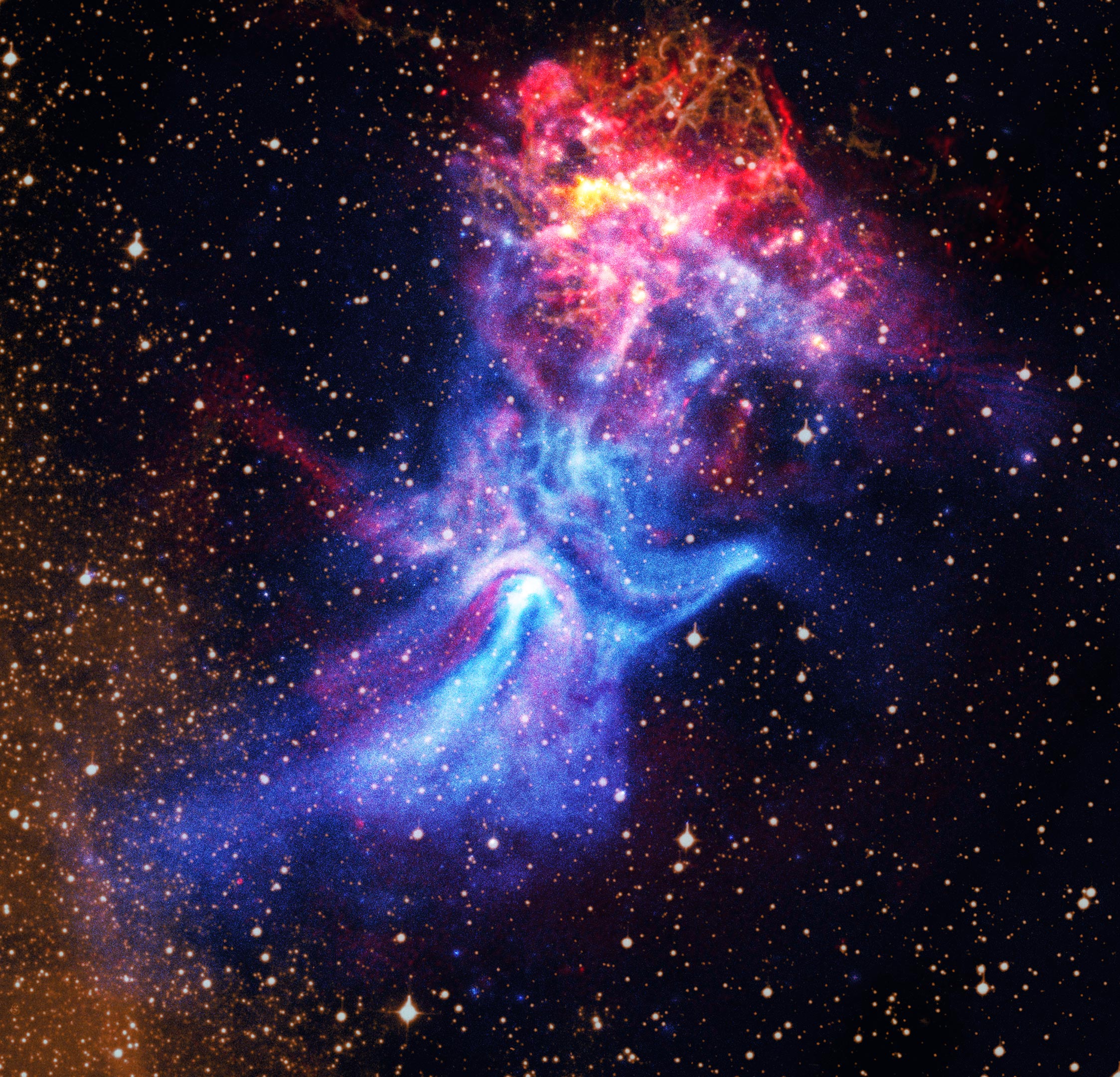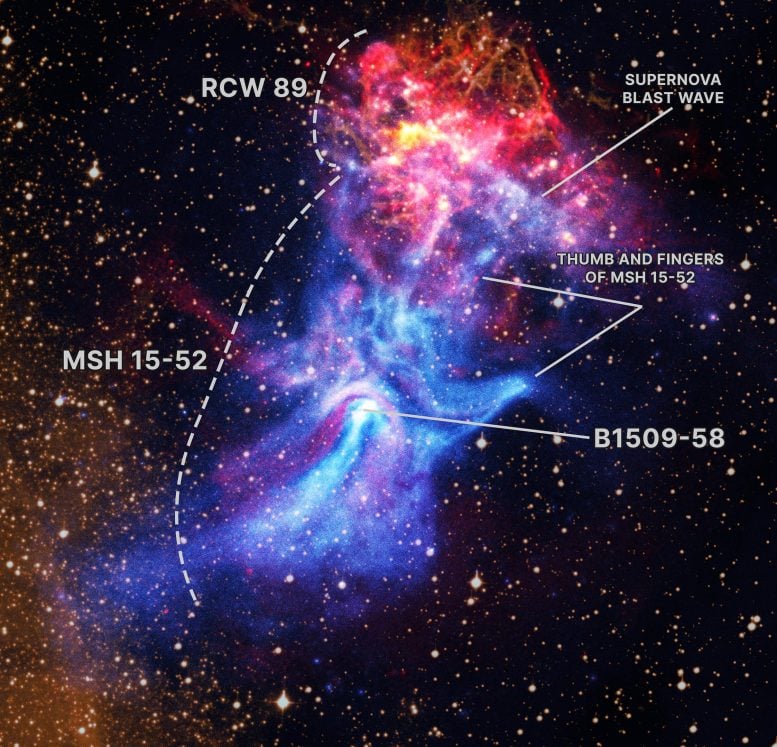The Cosmic “Hand of God” Just Got Even Stranger

- A stunning new composite image captures the hand-shaped nebula MSH 15-52 along with the remains of the supernova that formed it.
- Astronomers combined X-ray data from NASA’s Chandra Observatory with radio observations from the Australia Telescope Compact Array, uncovering fresh details and hidden structures.
- At the center lies a pulsar, an ultra-dense neutron star spinning rapidly, which fuels the creation of the nebula.
- This extraordinary system began when a massive star used up its nuclear fuel, collapsed inward, and then exploded in a brilliant supernova.
A Cosmic Hand in Space
In 2009, NASA’s Chandra X-ray Observatory unveiled a striking image of a pulsar surrounded by a nebula shaped like a giant hand.
Since that first release, astronomers have continued to track the object using Chandra along with other powerful telescopes. Most recently, scientists paired new radio observations from the Australia Telescope Compact Array (ATCA) with Chandra’s X-ray data, creating a more detailed portrait of the aftermath of this stellar explosion and offering new clues about its unusual appearance.
Fresh Insights from Radio and X-Ray Data
At the heart of this dramatic view is pulsar B1509-58, a rapidly rotating neutron star that measures only about 12 miles across. Despite its small size, it produces a sprawling nebula (known as MSH 15-52) that stretches more than 150 light-years, or roughly 900 trillion miles. This vast cloud of energetic particles takes on the eerie shape of a human hand, with a glowing palm and outstretched fingers reaching upward to the right in X-ray light.
The pulsar itself was born when a massive star collapsed after exhausting its supply of nuclear fuel. The inward crash triggered a supernova, blasting the star’s outer layers into space and leaving behind the dense remnant.
Today, B1509-58 rotates nearly seven times per second and carries a magnetic field estimated to be about 15 trillion times stronger than Earth’s. This extraordinary combination of speed and magnetism makes it one of the galaxy’s most powerful natural dynamos, driving a fierce outflow of electrons and other particles that form the nebula.

One of the Galaxy’s Most Powerful Generators
In this new composite image, the ATCA radio data (represented in red) has been combined with X-rays from Chandra (shown in blue, orange and yellow), along with an optical image of hydrogen gas (gold). The areas of overlap between the X-ray and radio data in MSH 15-52 show as purple. The optical image shows stars in the field of view along with parts of the supernova’s debris, the supernova remnant RCW 89. A labeled version of the figure shows the main features of the image.
Radio data from ATCA now reveals complex filaments that are aligned with the directions of the nebula’s magnetic field, shown by the short, straight, white lines in a supplementary image. These filaments could result from the collision of the pulsar’s particle wind with the supernova’s debris.

Mysterious Filaments and Magnetic Fields
By comparing the radio and X-ray data, researchers identified key differences between the sources of the two types of light. In particular, some prominent X-ray features, including the jet towards the bottom of the image and the inner parts of the three “fingers” towards the top, are not detected in radio waves. This suggests that highly energetic particles are leaking out from a shock wave — similar to a supersonic plane’s sonic boom — near the pulsar and moving along magnetic field lines to create the fingers.
The radio data also shows that RCW 89’s structure is different from typical young supernova remnants. Much of the radio emission is patchy and closely matches clumps of X-ray and optical emission. It also extends well beyond the X-ray emission. All of these characteristics support the idea that RCW 89 is colliding with a dense cloud of nearby hydrogen gas.
However, the researchers do not fully understand all that the data is showing them. One area that is perplexing is the sharp boundary of X-ray emission in the upper right of the image that seems to be the blast wave from the supernova — see the labeled feature. Supernova blast waves are usually bright in radio waves for young supernova remnants like RCW 89, so it is surprising to researchers that there is no radio signal at the X-ray boundary.
Perplexing Boundaries and Missing Signals
MSH 15–52 and RCW 89 show many unique features not found in other young sources. There are, however, still many open questions regarding the formation and evolution of these structures. Further work is needed to provide better understanding of the complex interplay between the pulsar wind and the supernova debris.
A paper describing this work, led by Shumeng Zhang of the University of Hong Kong, with co-authors Stephen C.Y. Ng of the University of Hong Kong and Niccolo’ Bucciantini of the Italian National Institute for Astrophysics, has been published in The Astrophysical Journal.
Reference: “High-resolution Radio Study of Pulsar Wind Nebula MSH 15–52 and Supernova Remnant RCW 89” by S. Zhang, C.-Y. Ng and N. Bucciantini, 20 August 2025, The Astrophysical Journal.
DOI: 10.3847/1538-4357/adf333
NASA’s Marshall Space Flight Center in Huntsville, Alabama, manages the Chandra program. The Smithsonian Astrophysical Observatory’s Chandra X-ray Center controls science operations from Cambridge, Massachusetts, and flight operations from Burlington, Massachusetts.
Never miss a breakthrough: Join the SciTechDaily newsletter.
Source link

